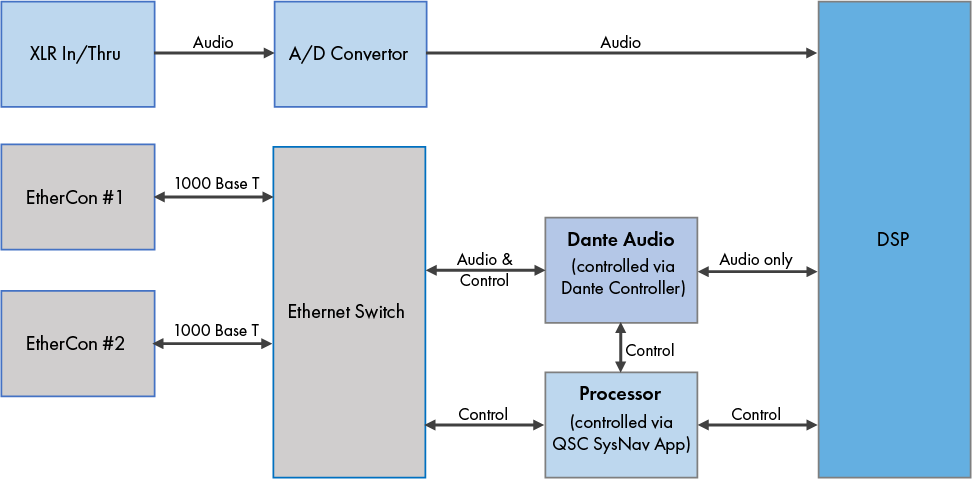Connection Requirements
Read this topic to understand the network connections available on L Class loudspeakers, the types of network traffic to and from L Class loudspeakers, as well as the requirements for successful communication between SysNav and L Class loudspeakers.
SysNav control requires a network connection to the L Class loudspeakers and a Wi-Fi router. If the SysNav host device is using a wireless connection, it must be connected to the same network as the L Class loudspeakers. There are two methods to connect to an L Class array:
Home Run Connection
A connection in which SysNav in which each has its own dedicated cable running directly to the amplifier, ensuring better control over impedance, power distribution, and audio quality.
Note: The IR connection only works within a single array. A separate wired connection is required for each array.
Daisy Chain Connection
A connection to SysNav that involves linking multiple speakers together in sequence before reaching the amplifier, which can simplify wiring but may impact impedance, power balance, and overall sound performance.

SysNav control requires a network connection to the L Class loudspeakers and a Wi-Fi router. If the SysNav host device is using a wireless connection, it must be connected to the same network as the L Class loudspeakers.
A Dante digital audio network may also be connected using the same cabling and router. See Dante and AES67 Connections and Requirements for more detail.
Network traffic to and from L Class loudspeakers is categorized into Processor traffic (see Control Requirements) and Dante Audio traffic (see Dante and AES67 Connections and Requirements).

Network switches must be configured to allow passage of multicast traffic.
Discovery Protocol
UDP destination IP 224.0.23.175 on port 4333. This is used to discover L Class loudspeakers on the network by name regardless of IP address.
Telemetry
UDP destination IP 239.255.81.83 on port 4334. After discovery is complete, loudspeaker telemetry data is sent over this address and port, including meter, voltage, and temperature data.
Note: If you are planning to pass Dante networked audio to L Class loudspeakers, follow the requirements and guidelines in Audinate's Dante Information for Network Administrators, which includes discovery, QoS, and multicast (IGMP) requirements and information.
Dante Connection Overview
There are two audio inputs to L Class loudspeakers: an analog input that is always active and a Dante input that receives a digital audio signal when connected to a Dante Network and subscribed to a Dante transmitter. L Class loudspeakers can also serve as Dante transmitters, making analog audio input signals available on a Dante network.
Dante audio routing between L Class loudspeakers and other Dante devices is managed by Audinate’s Dante Controller software. Details regarding operation of Dante Controller are beyond the scope of this document but here a few terms to know:
-
Device
 Any SysNav-compatible active loudspeaker. – Any piece of equipment with one or more Dante inputs and/or outputs.
Any SysNav-compatible active loudspeaker. – Any piece of equipment with one or more Dante inputs and/or outputs. -
Media Channels – Media channels are transmitted and received between devices by connecting transmitters and receivers.
-
Transmitters – Sometimes abbreviated TX. A transmitter represents an audio channel output (or source).
-
Receivers – Sometimes abbreviated RX. A receiver represents an audio channel input (or destination).
-
Subscription – A receiver connection to a transmitter is referred to as a subscription. Subscriptions are managed using the matrix in the Routing area of a Dante Controller.
Tip: If you are not already familiar with Dante Controller, see Audinate's Dante Controller User Guide.
AES67 Connections
In addition to Dante, L Class loudspeakers are compatible with AES67. AES67 operation may be enabled from Dante Controller.
What's in a name?
Quite a lot, actually. Dante Controller supports naming of devices, transmitters and receivers. Without these friendly names, Dante routing would be daunting. Here is how Dante, L Class loudspeakers, and SysNav interact regarding names.
|
Firmware Releases: Prior to Fall 2023 |
Firmware Releases: Fall 2023 |
|---|---|
|
The name of the Dante transmitter that a SysNav device is subscribed to is displayed in SysNav. |
The name of the Dante transmitter that a SysNav device is subscribed to is displayed in SysNav. |
|
When Dante Controller first connects to an L Class loudspeaker, the loudspeaker model name and last 6 digits of the MAC address are displayed. |
When Dante Controller first connects to an L Class loudspeaker, the loudspeaker’s SysNav “friendly name” is displayed in Dante Controller. If the loudspeaker has no friendly name, the model name and last 6 digits of the MAC address are displayed. |
|
Changes made to the name in Dante Controller are not reflected in SysNav. |
SysNav device name changes are reflected in Dante Controller. |
|
Changes made to the name in SysNav are not reflected in Dante Controller. |
Dante Controller device name changes are reflected in SysNav. |
